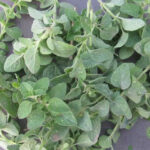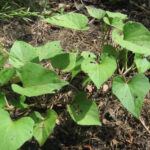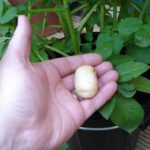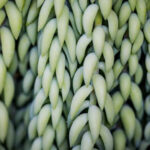Growing arugula provides you with peppery flavor and an amazing source of vitamins A, C, and K. These tart-tasting leaves have become a signature part of cuisine. In a salad, bright green arugula leaves are a perfect addition for an added punch of flavor. And if you grow arugula at home, you’ll have a constant supply!
Historians believe that arugula was once referred to as “oroth”, a green leaf that was referenced in the Old Testament of the Bible. Indeed, this lovely plant was grown throughout the Mediterranean region during Roman times. Also popular during the Middle Ages in Britain, it was then referred to as rocket or garden rocket. The French called it roquette, possibly inspiring the name of rocket.
It’s a fascinating plant, and you’ll love growing and consuming these salad greens!
Quick Care Guide
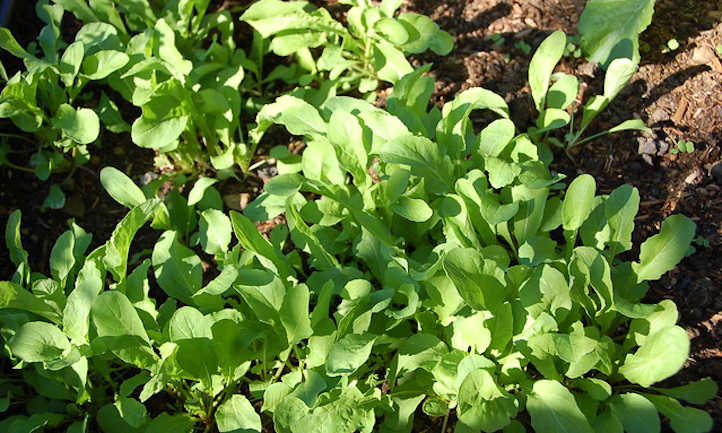
| Common Name(s) | Garden rocket, rocket salad, rugula, colewort, rucola, roquette |
| Scientific Name | Eruca vesicaria or Eruca sativa |
| Days to Harvest | 40-60 days |
| Light | Full sun to partial shade |
| Water: | Keep the soil moist |
| Soil | Humus-rich, well drained soil |
| Fertilizer | Once to twice per growing season |
| Pests | Flea beetles, aphids, cabbage loopers |
| Diseases | Downy mildew, bacterial leaf spot, damping off |
All About Arugula
Eruca vesicaria is the botanical name for arugula. At one point, it was also referred to as Eruca sativa. In fact, there are about 40 different botanical names used over time to refer to it. But if this seems confusing, you can also refer to it as garden rocket, roquette, colewort, rugula, rucola, or even just arugula.
Its origins are in the Mediterranean, stretching from Turkey, Syria and Lebanon on the eastern edge all the way west to Portugal and Morocco. A member of the Brassicaceae or mustard family, it shares its genetics with other cruciferous vegetables like kale, cabbage, mustard, and broccoli. Leaning more towards the peppery flavor of the mustard side of the family, they have become a popular salad green.
This leafy annual stays around a foot to two feet tall, although it ranges anywhere from 8” to nearly 40”. The leaves are pinnate and often 2-3” long, attached to slender stems. They’re described as a longer, narrower lettuce leaf. Rocket produces inflorescences of white flowers with purplish veins running through them. As the flowers go to seed, they form long, tight seed pods. There is even a wild arugula cultivar, which is heat tolerant.
Both the leaves and the arugula flowers are eaten. The edible seeds can also be pressed to make taramira seed oil instead. Some sources claim arugula was said to be an aphrodisiac by the Romans. It’s rumored to have been disallowed in monastery gardens because of this. However, lettuce was supposed to soothe one’s passions, and thus arugula was blended into mixed salads for this purpose!
How To Plant Arugula

For most growers, two seasons are ideal to grow arugula. Plant arugula seeds as soon as the soil can be worked in early spring for an early-year crop. When it dies back in late summer, wait for the weather to cool and replant in the fall for a second harvest. As soon as the soil freezes, it will die back again, so harvest before frosty conditions come.
If you want a continual harvest, sow seeds every 2-3 weeks throughout the season. You’ll need an area of the yard protected from extreme heat or cold, but that gets at least partial sun. This plant is forgiving of somewhat shady conditions as long as there’s bright ambient light, but won’t perform well in scorching heat, so pick your location accordingly.
Or container grow arugula. When you plant arugula in containers, you can move your plant to optimize its placement depending on your local conditions. It grows well both indoors and out as long as it has enough bright light.
Sow seeds about ¼” deep and about an inch apart. Space rows at least 10 inches apart for good outward development and to allow ample room for healthy root development. Once seedlings emerge, it’s time to thin seedlings. Keep arugula plants 4 inches apart if you grow arugula for young leaves, 6” for mature leaves or seeds.
It is possible to broadcast-sow arugula, with or without other leafy greens, to create a thick and lush raised beds. This works best for leaf lettuces, mustards, or other related plants. Thin seedlings appropriately and harvest from these beds regularly to allow for more plant development. Starting seeds in advance and transplanting young plants out is not impossible, but may be tricky. It’s easier to sow where you plan to have your arugula growing.
Caring for Arugula Plants
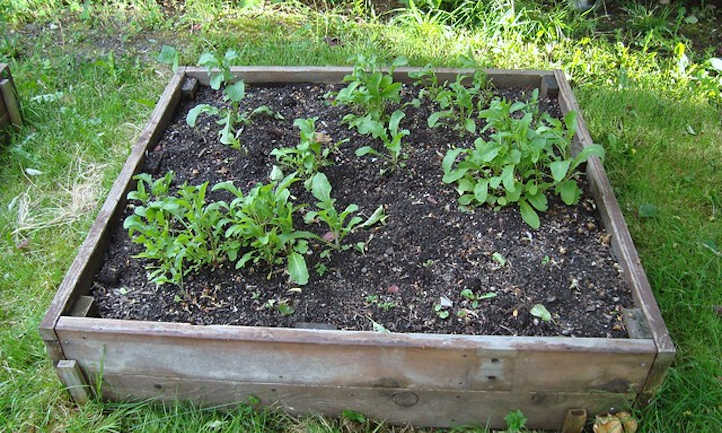
So now that you know how planting arugula works, what conditions do you need to grow arugula in your garden for the best spring or fall harvest? Let’s discuss how to grow your own arugula!
Sun and Temperature for Arugula Plants
Full sun to partial shade is best when you grow arugula. Six to seven hours of daily sunlight is required for them to grow. They can accept indirect, but bright lighting in lieu of direct full sun, making them an excellent choice for some of your partially-shaded garden areas.
A cool weather plant, arugula greens develop best in temperatures ranging between 45-65 degrees Fahrenheit. Once the weather in the garden reaches the 80’s or higher, your plant bolts to flower and seed production. Once it produces seed, the plant dies. Arugula is tolerant to mild frosts, but can be damaged and die back in true freezing conditions. If you’re in a mild climate, grow arugula all winter long to have a constant supply.
Arugula Water & Humidity
Keeping the soil evenly moist is best when you grow arugula. Water the plants in the morning, as this allows plenty of time for leaf surfaces to dry out in the sun. Mulching the garden can also keep the soil consistently moist and reduce watering frequency. A drip irrigation system or soaker hose underneath the mulch can make watering easy.
Soil for Growing Arugula
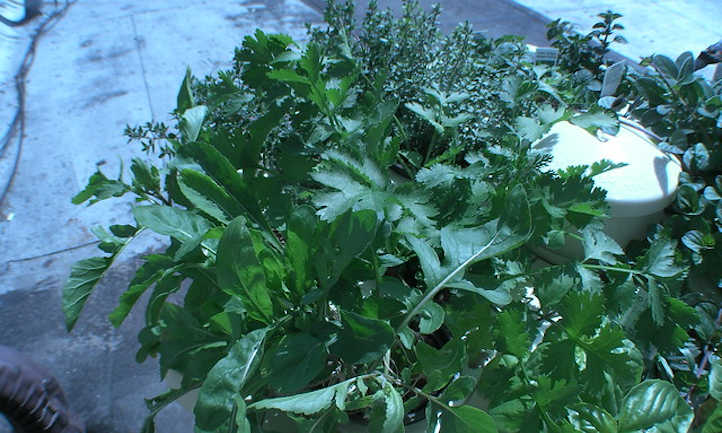
Humus-rich, well-drained soil is what your plants will prefer. However, they’re tolerant of a wide range of garden soil types as long as they retain moisture. If you have sandy soil, amend it with compost and horse manure or cow manure to provide extra moisture retention. Worm castings can also be applied for additional moisture retention.
Hard-packed clay should be broken up by a lot of compost or manure as well. This will reduce the likelihood that it will become hard and prevent easy root development. The pH level for your arugula should be neutral, with a 6.0-7.0 range considered ideal. But they will tolerate slight acidity to slight alkalinity as well.
Fertilizing Arugula
Provide a balanced fertilizer for your arugula plants to ensure they have what they need to develop healthy young leaves. A dry granular formula can be applied once or twice where arugula grows during the growing season (whether spring or fall). Alternately, use diluted liquid fertilizers at the base of the plant as needed to keep the fresh greens healthy.
Pruning Your Plants
Arugula doesn’t need pruning, as you’ll harvest leaves regularly to eat it! But if you do end up with too much to eat, pinch off any yellowing leaf material. Make sure that your older plants have a space between them, at least a few inches apart, to allow for good airflow around them. If they’re clustered too closely together, you may encounter various plant disease issues.
At the end of the growing season in late summer or fall, your plants will die back due to either heat in the summer or freezing conditions in the winter. At those times, remove the plants and prepare the bed for a different crop, or cover-crop it until it’s time to plant again.
Arugula Plant Propagation
Arugula seeds from unreliable sources may be carriers of some fungal diseases. Purchase seeds from reliable sources or treated them with fungicides. This prevents fungal issues spreading to your soil. Since this is a plant that mostly thrives in a mild climate, start it from seed. While it is possible to grow arugula from just the base and shallow root system of the plant, it will be stressed from the loss of its leaves and may bolt. Plant arugula seeds 1-2 inches apart.
How To Harvest Arugula and Store It

Now you’ve got an abundance of healthy young leaves. So how do you harvest these arugula leaves and keep them fresh?
Harvesting Arugula
Whether you’re harvesting arugula in spring or fall, you’ll use the same methods. Harvest the outer leaves at no more than a third of each plant if you want to use a cut-and-come-again method to extend that plant’s productivity for a longer period of time. A younger and smaller plant yields softer and more tender leaves than the older ones. These have a mild flavor.
You can harvest arugula when it’s very young for baby greens, and they’re a great addition of peppery flavor to any salad. As the arugula leaves get older, their mild flavor is more pronounced and reminiscent of mustard greens with a slightly peppery bite.
If your plant has flowered, the outer leaves on the plant will be more bitter. They may also be tough, but they’re still edible if you want to get one last meal from the plant. Looking to harvest arugula seeds for planting or seed oil? Wait for the plant to flower and form seed pods. Once those dry out, cut off the pods and keep them somewhere to completely dry out before popping them open to save the seed.
Storing Arugula
Rinse off your fresh harvest to remove garden pests or dirt, and blot all leaf surfaces dry with a paper towel. Then, use a long strip of paper towel and lay your arugula leaves on it, gradually rolling them up into a neat bundle with all the tender leaves surrounded by towel. Moisture is the enemy when storing any greens, and this reduces the likelihood of condensation forming.
Place your rolled up arugula into a storage bag or container in the crisper drawer of the refrigerator. Unfortunately, there aren’t viable ways to provide long-term storage for these greens that don’t make them unappetizing or cause them to lose flavor, so stick with fresh.
Troubleshooting Arugula Issues
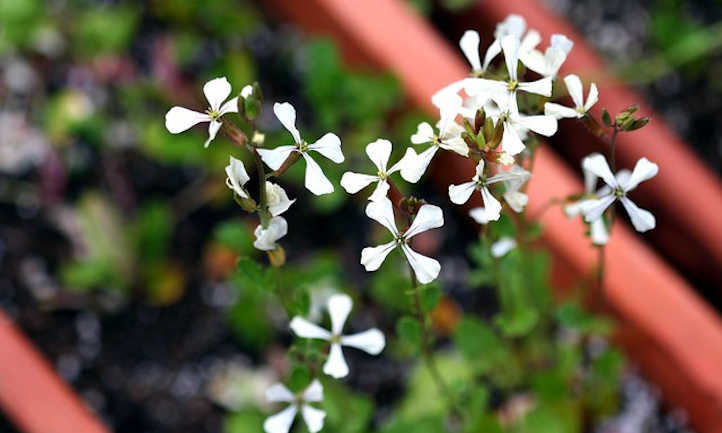
Like most salad greens, you are going to find pests trying to snack on them, or disease issues on leaf surfaces. Let’s talk about any problems you may face!
Growing Problems
Most of the non-pest or disease-related issues with arugula revolve around the weather. It’s a cool-weather crop, so unless you are growing a heat tolerant variety, once the temperature goes up it will bolt and go to seed quickly. To get an early-season crop, plant arugula seeds in early spring. They’ll need 40-60 days to fully mature, but you can begin cut-and-come-again harvesting earlier than that.
Pests of Arugula
The worst pest of arugula for many is the flea beetle. These hungry pests chew holes in the arugula leaves. Their larvae live in the soil and gnaw on shallow root system. It’s essential to prevent these from taking hold in your garden. Neem oil and pyrethrin spray are effective organic treatments against flea beetles, although pyrethrin seems to be more effective at killing them. Floating row covers keep them out of your plants too.
Aphids are the other major issue you’ll encounter. The cabbage aphid, green peach aphid, and potato aphid are all drawn to your arugula plants. These garden pests spread disease and suck the moisture out of the plants. Neem oil, pyrethrin, or insecticidal soap are effective control methods.
Cabbage loopers are green caterpillars that feast on fresh leaves of arugula, putting holes in them and leaving small poppy-seed-like frass behind where arugula grows. Hand pick them from your own garden or treat them with BT spray. Floating row covers are a great preventative measure.
Arugula Diseases
One of the most common diseases on arugula is downy mildew. This causes yellowish spotting on the upper surfaces of the leaf, with a grey mildew or mold-like substance underneath. It’s treated with organic liquid copper fungicide. You can prevent the development of downy mildew with regular applications of neem oil.
When the temperature is warm and there’s a lot of humidity in the air, plants risk developing bacterial leaf spot. Usually a Pseudomonas species, this bacteria has no organic cure. Remove infected leaves, then spray the remainder of the plant weekly with a liquid copper fungicide to ensure that any remaining spores can’t spread. If the problem persists, remove infected plants entirely.
Finally, damping off caused by Pythium fungi in the soil can be an issue for young arugula plants. Plant in sterile soil when possible to reduce the risk of planting arugula in contaminated soil. If you’re growing in an older bed, pre-treat the seeds and planting area with beneficial mycorrhizae to reduce the likelihood of the pythium attacking. Remove plants that show signs of damping off. Avoid growing the leaves in areas where this has happened previously.
Frequently Asked Questions
Q: How long does arugula take to grow?
A: After you plant arugula and germination occurs, it takes anywhere from 45-60 days to grow.
Q: Does arugula regrow after cutting?
A: Yes, it can. If you want to continually harvest from a single plant, take ⅓ or less of the plant at a time. Plants with all of the foliage removed may immediately try to go to seed production rather than replenish their leafy greens.
Q: Can you eat arugula after it flowers?
A: Arugula leaves become bitter and tough once the plant has flowered. For best flavor and texture, harvest from plants that haven’t flowered. They’re still edible once they’ve flowered, just not as favorable!
Q: Does arugula like sun or shade?
A: Grow arugula in full sun. Some partial shade is fine.
Q: Is arugula easy to grow?
A: As long as you time your plantings correctly and grow arugula in the proper conditions, it’s very easy to grow.
Q: Does arugula come back every year?
A: Most people grow arugula and plant arugula as an annual green. However, if you allow it to go to seed, it can be perennial.
Q: How long does arugula plant live?
A: Most of the time, you’ll grow arugula just for one season. If you allow it to self-seed, you can keep growing it for multiple years in a row.
Q: What can you not plant near arugula?
A: Don’t grow arugula near nightshades, like tomatoes, eggplant, ground cherry, etc.


